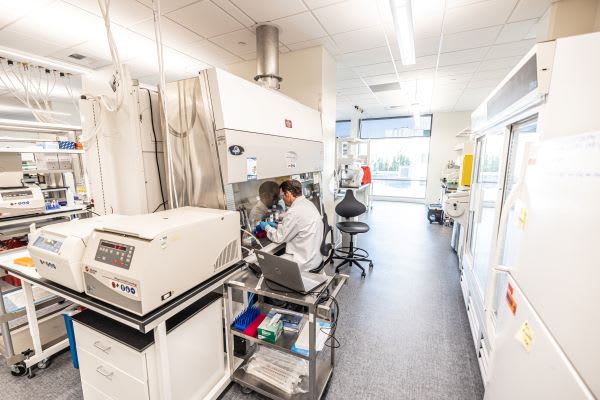Radiopharmaceutical therapy offers transformative, personalized treatment for patients with prostate cancer

[6 min read]
In this article:
- Swedish is the first Clinical Radiopharmaceutical Therapy Center of Excellence in the Puget Sound region.
- Expert teams at the Swedish Cancer Institute offer some of the most advanced, personalized radiopharmaceutical therapies for patients with cancer.
- Two radiopharmaceutial therapy experts from Swedish explain how the treatments work, how they are administered and which patients benefit most.
Earlier this year, the Swedish Cancer Institute’s (SCI’s) Radiation Oncology Department received the prestigious designation of Clinical Radiopharmaceutical Therapy Center of Excellence (RTCOE) from the Society of Nuclear Medicine & Molecular Imaging. Swedish is now the first RTCOE in the Puget Sound area and the second in the state of Washington. The designation recognizes Swedish’s radiation oncology experts and the high-quality radiopharmaceutical therapy (RPT) available to patients with cancer as part of their care plan.
The therapy is delivered by highly qualified radiation oncology physicians at technologically advanced sites. To learn more about this treatment and Swedish’s exceptional program, we spoke with two experts from SCI, Vivek Mehta, M.D., director of the Center for Advanced Targeted Radiotherapies and Sharon Bruce, a SCI nuclear medicine technologist.
What is radiopharmaceutical therapy?
Dr. Mehta: Unlike traditional pharmaceuticals that rely on chemical reactions within the body, radiopharmaceuticals harness the power of radioactivity to treat cancer. These unique compounds contain radioactive elements that emit radiation suitable for diagnostic or therapeutic purposes.
Specifically, therapeutic radiopharmaceuticals are designed to deliver targeted radiation doses to diseased cells, found in cancerous cells . By attaching radioactive isotopes to molecules that preferentially accumulate in specific cells, these treatments can selectively destroy cancer cells while minimizing damage to surrounding healthy cells and tissue.
The development and application of radiopharmaceuticals continues to evolve, driven by advancements in nuclear medicine, chemistry, and molecular biology. Ongoing research aims to enhance the specificity, effectiveness, and safety of these compounds, expanding their utility in both diagnostics and therapies. As technology progresses, radiopharmaceuticals are poised to play an increasingly important role in personalized medicine, offering tailored diagnostic insights and precise therapeutic interventions that improve patient outcomes and quality of life.
Sharon Bruce: RPT delivers radiation therapy that is preferentially taken up by cancerous cells. Once taken up by the cancer cells it can kill them by breaking up their DNA. Other treatments, for example external beam therapy, must penetrate through tissue, cells and other structures on its way to the target treatment object.
Can you give us an example of how RPT is used in a specific treatment?
Dr. Mehta: At Swedish, we offer lutetium Lu 177 vipivotide tetraxetan, commercially known as Pluvicto, for the treatment of metastatic prostate cancer in patients who have developed resistance to standard treatments like hormone therapy and chemotherapy.
Pluvicto is designed to target prostate-specific membrane antigen (PSMA) receptors, which are on the surface of prostate cancer cells, allowing the radiopharmaceutical to selectively bind to prostate cancer cells wherever they may have spread in the body, causing damage to their DNA and leading to cell death. This targeted radionuclide therapy is particularly beneficial for treating metastatic prostate cancer because it can reach cancer cells throughout the body, including those that may not be accessible through surgery or other localized treatments. This approach can help in reducing tumor burden, alleviating symptoms, and potentially prolonging survival in patients with advanced disease.
What other types of cancers can be treated with radiopharmaceutical therapy? How do the treatments differ?
Sharon Bruce: Lutetium Lu 177 dotatate is used to treat certain neuroendocrine tumors. The drug’s brand name is Lutathera and it’s given by IV administration.
Yttrium-90 (Y90), which is marketed as SIR-spheres or Theraspheres, is a type of radiation therapy is used for treating liver tumors. The radioactive dose is embedded in glass beads which are injected into the blood vessels directly feeding the tumor, using interventional radiology guidance.
Radium Ra 223 dichloride, which is marketed under the name Xofigo, is another treatment for prostate cancer when the disease has primarily spread to the bones.
The first radiopharmaceutical therapy treatment was used to treat thyroid cancer. It’s a form of iodine called I-131 and is administered as a pill to be swallowed. It started in the early 1940’s and is still the gold standard today.
Each treatment has its own preparations and radiation safety precautions. Our physics and/or radiation safety team will provide instructions for the patient before each treatment.
What should patients know about why SCI is an exceptional place to receive radiopharmaceutical therapy?
Dr. Mehta: SCI is committed to the highest levels of excellence in care for every one of our patients, this includes our commitment to advancing treatment options through research, and our comprehensive, patient-centered approach that prioritizes individualized care and outcomes. Throughout our history, SCI has been a leader in advancing radiation oncology through research, clinical trials, and multidisciplinary collaboration. The institute has been instrumental in developing and refining various radiation therapy techniques, such as intensity-modulated radiation therapy (IMRT), stereotactic body radiation therapy (SBRT), and brachytherapy. These innovations have allowed SCI to provide highly precise and effective treatments tailored to each patient’s specific cancer type and stage.
Our commitment to excellence in radiation oncology is reflected in our multidisciplinary approach, state-of-the-art facilities, and dedicated team of oncologists, physicists, and support staff. We are singularly dedicated to upholding SCI’s legacy of compassionate care and innovation across the board and in our own field of radiation oncology. We want to ensure that our patients receive the best possible treatment and support throughout their cancer journey.
Learn more and find a physisan or advanced care practitioner (ACP)
At Swedish, we combine leading-edge treatment for prostate cancer with the highest levels of compassionate care. You can talk to someone or schedule an appointment with an expert at SCI by calling 1-855-XCANCER(1-855-922-6237). Learn more about radiation therapy at our website.
Whether you require an in-person visit or want to consult a doctor virtually, you have options. Contact Swedish Primary Care to schedule an appointment with a primary care practitioner. You can also connect virtually with your doctor to review your symptoms, provide instruction and follow up as needed. And with Swedish ExpressCare Virtual you can receive treatment in minutes for common conditions such as colds, flu, urinary tract infections, and more. You can also use our provider directory to find a specialist or primary care physician near you.
Information for patients and visitors
Related resources
Full speed ahead for prostate cancer detection and treatment
Prostate cancer: What you need to know
Prostate cancer: All hands on deck for treatment success | The Seattle Times
At Swedish, a robotic surgery milestone
Men’s health: It’s never too early to start annual exams
This information is not intended as a substitute for professional medical care. Always follow your health care professional’s instructions.
Providence Swedish experts in the media
Follow us on Facebook, Instagram and X.



